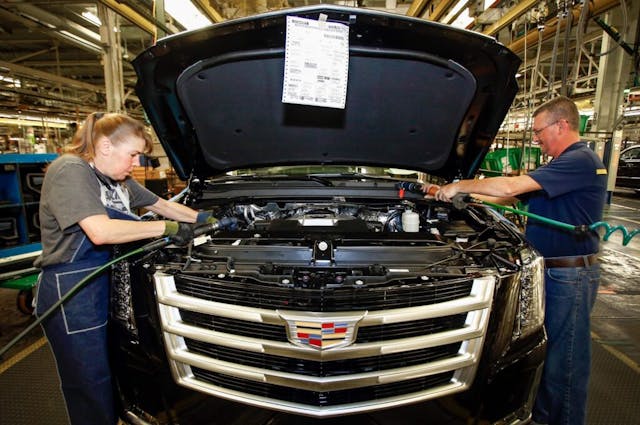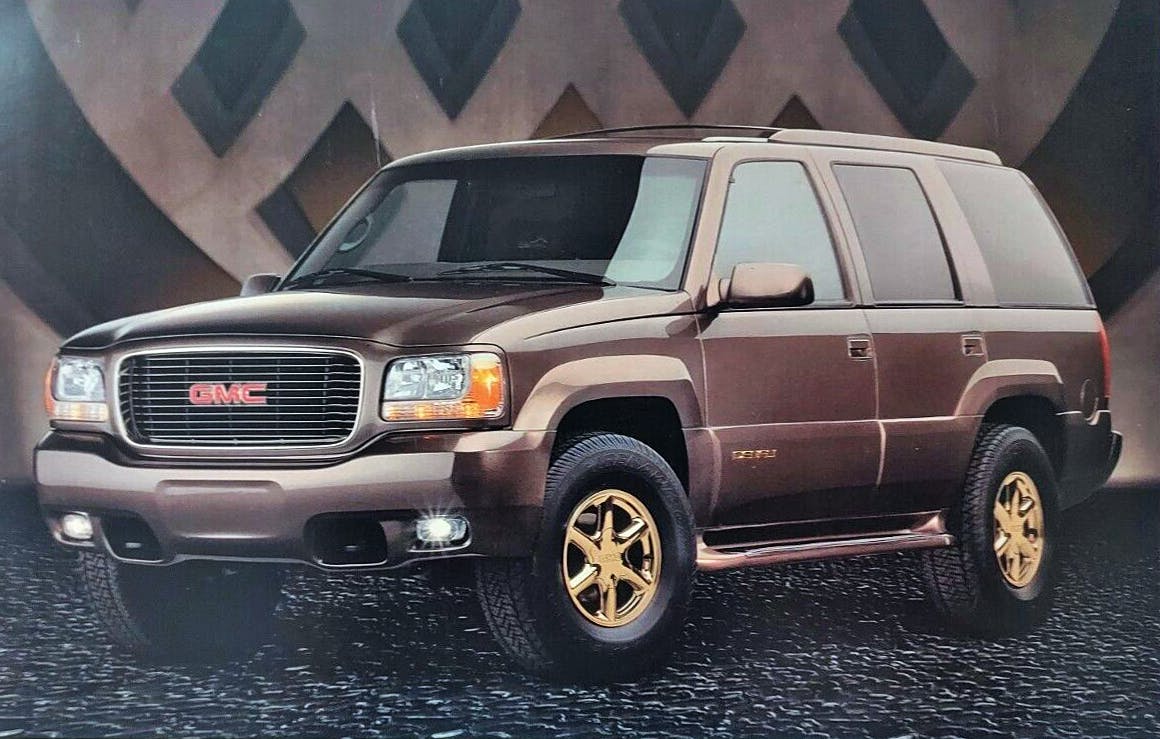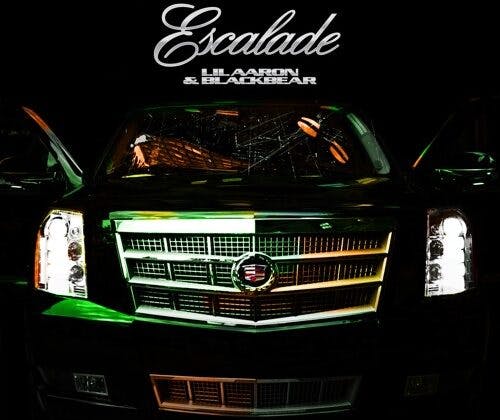Most car enthusiasts prefer to look down on the practice of badge engineering, where an automaker borrows an existing template from another brand or sub-brand to create a “unique” vehicle. Badge-designed vehicles are some of the lowest hanging fruit in the automotive world, but they also have an impressive track record of success. Tesla has proven that wealthy buyers don't care if the Model Y SUV bears a striking resemblance to the Model 3 sedan. Badge engineering can be the seed that germinates the light of an entire brand.
That's exactly what happened 25 years ago this year. That's when Cadillac saw the success of GMC's luxury SUVs, rivaling General Motors around town, and decided it needed to jump on the bandwagon. Before we get into this iconic SUV that forever changed our perception of Cadillac, let's take a look at how we got here.
1998 GMC Yukon Denali Concept GMC
1999 Cadillac Escalade Cadillac
GMC's Denali models are now part of a sub-brand with a clear mission to differentiate themselves with a “first-class designation.” The strategy is clearly working, and its success began with his 1998 concept vehicle, which was intended to capitalize on the booming luxury SUV segment. GMC's first Denali truck didn't look like your typical '90s SUV. The front end has been given a softer, more organic shape and is finished in luxurious Kodiak Bronze paint and gold-plated accents. Inside was a floor-standing console with a VCR and his two phones, Bose Acoustimass audio, and a roof-standing console with a flat screen TV. GMC declared that the sparkling Yukon Denali closely resembles the gold deposits found around Alaska's Mount Denali, as its “high-quality amenities represent the pinnacle of style and luxury in the SUV segment.”
While many of the concepts were purely car show settings, the exterior styling and decadent interior (complete with Zebrano wood trim, a material worthy of a Cadillac STS!) really made it productive. GMC had a winner on its hands. When our own Larry Webster reviewed his Denali, an original Yukon, we learned that “his 80 percent of the regular Yukon was sold with every available option.” In hindsight, there's no doubt that GMC “needed something for customers to step up from the regular Yukon.” Hey, did the strategy work? Park one of his bulbous bad boys next to his GMT400 truck at a GM dealership, and a GMC would be like a Cadillac in a rental lot full of Caprices and Cavaliers.
When the '98 Yukon Denali set off a wake-up call for badge engineering, the GM wreath-and-coat-wearing brand saw the writing on the wall. “If Cadillac hadn't moved quickly to quench the dealer's thirst, the whole building would have been connected to this.” The metaphorical wall was caused by a rogue navigator and a young-blooded Yukon man will be engulfed by a five-alarm fire.
The Denali was a great template for a sensation, and the 1999 Cadillac Escalade had several things that made it better than its GMC twin. The seats were sewn and padded like those in a real Deville, and the egg-crate grille gave the Escalade's rounded profile a little more textural contrast. Even the name――Escalade—Rolls off the tongue in style. This is something salespeople would eat up, and something Cadillac owners clearly couldn't resist.
ask motor week Sharing auto enthusiasts' disdain for blatant badge engineering is a bridge too far. Because “with only minor changes, [the Yukon] Up to Cadillac specifications. ” But the show's hosts aren't the only ones rejecting such shoddy practices. At the time, the media gave more leeway to the Lincoln Navigator, which came out a year before the Escalade, because unlike GM, Ford didn't have divisions across divisions vying for the same gilded utility pie. It is. (Maybe Ford was lucky that Mercury didn't need a full-size SUV?)
Although the original Escalade Vaughan's GMT400 Vaughan lacked the third row seat provided by Lincoln's more modern UN93 underpinnings; motor week Cadillac noted that it boasted excellent ride quality and quick acceleration. It may be a far cry from the big Caddy of yesteryear, but the 1999 Escalade was a fitting brand ambassador for the burgeoning luxury utility market.perhaps motor week It was most appropriate when we ended our review by suggesting that the 1999 Escalade is “a new kind of Cadillac for a new customer and a new millennium.”
Since the early days… cash record
To the present day… Lil Aaron | Soundcloud
There's a good chance that motor week Never before has the upbeat comment at the end of a review been so accurately conveyed. The Escalade became the de facto Y2K devil for America's upper class, giving Cadillac an advantage over other luxury automakers that lacked strong R&D budgets for trucks and SUVs.
The Escalade became the go-to, aspirational product for suburban families, luxury taxis, and airport livery fleets, and was embraced by younger generations in urban zip codes. With this, the Cadillac brand name has already become widely known, having been mentioned in over 11,000 of his songs by artists from various backgrounds. Donnelly Baxter, his manager of marketing for the Escalade, said: “Escalade is an iconic nameplate that resonates across eras, cultures and regions. It represents Cadillac as a brand and serves as a source of inspiration and a halo across our luxury lineup. It will have an effect.”

So let's go back to 1999 and this tall Cadillac that didn't get much focus. The Escalade was unique enough to allow customers to justify owning a “Cadillac his truck” and embrace the lifestyle of owning a true flagship in a class society while enjoying an upscale dealership experience.
When I toured the Arlington, Texas, assembly plant in 2003, I recognized both the engineering shortcuts and the Escalade's underlying appeal. I've scoffed at the big Caddy being assembled next to Suburbans and Tahoes during the week, but I couldn't help but stare as the Escalade's unique leather and wood dashboard moved down the assembly line alongside its bow-tie sibling. I couldn't stay there. Even in such a busy and hectic environment, the chrome-rimmed clock on the console caught my eye. By the time I reached the end of the assembly line, I had no doubt that the vehicle at the end of the assembly line had the same appeal as any other Cadillac. The success of the Escalade suggested that the average SUV buyer has no such pickiness about the company whose truck might end up on the assembly line, so this drug is a great way to help your For such a picky eater, it was surprisingly easy to swallow.

I was also tempted to visit Sewell Cadillac on my way out of Arlington to experience the finished product and complete the tour (so to speak). Two decades later, the shortcomings of a visit to the Escalade's birthplace in 2003 are now much less noticeable. Cadillac's large SUV is much improved, different and upgraded than its cousins from Chevrolet and GMC.
Looking back over a full 25 years, it's clear that the 1999 Cadillac Escalade was just the beginning of something special. From there, the product improved even further, earning it the right to receive the same recognition as the Cadillac DeVille and top-of-the-range Fleetwood before it.
***
Please check Hagerty Media Homepage So that you don't miss a single story, or even better, Please bookmark it. Get our best stories delivered straight to your inbox. Subscribe to newsletter.








